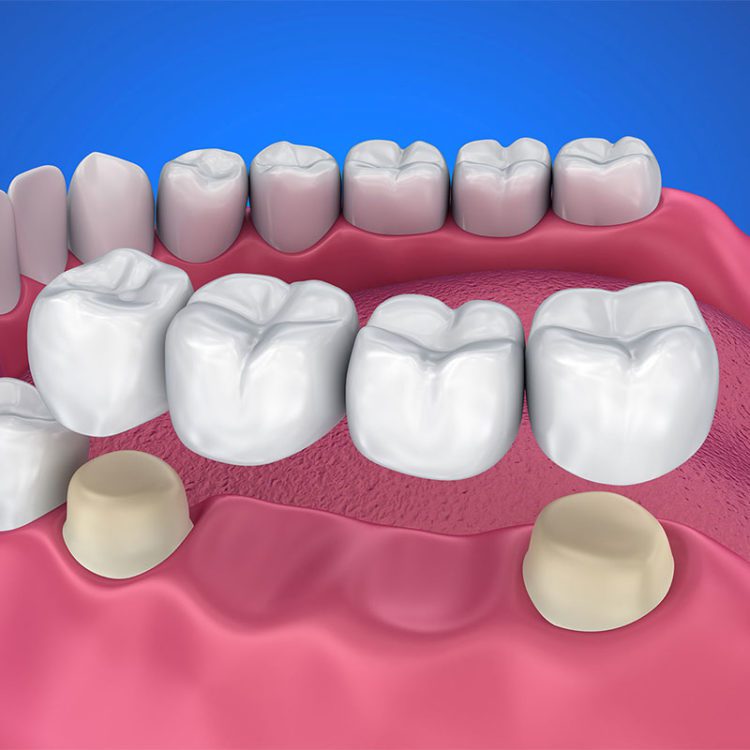What is Dental Bridge and Crown?
A dental bridge can be used to replace one or more missing teeth by using artificial teeth to bridge the gap. A dental bridge is often comprised of an artificial tooth or teeth (pontic) which are fused to crowns on either side for support. A dental crown is a restoration that covers the exposed surface of the tooth to provide strength or to improve its appearance.
Dental bridge and crowns are designed to match the natural shape and structure of the teeth and is made of different types of materials such as ceramic, metal ceramic, porcelain or zirconium.

Aesthetically Pleasing
Restores Function
Fixed Solution
How does a dental bridge look like?
A typical dental bridge consists of:
Abutment teeth: Two crowns are bonded to the teeth on either side of the missing teeth by a dentist. Your natural teeth or dental implants may serve as these anchoring or supporting teeth.
Pontic: This artificial tooth bridges the space and is attached to the crowns.
When is a dental crown required?
- If you need a dental bridge, crowns are a must.
- To cover a tooth that is discolored, misshaped, or poorly formed.
- To protect or restore a fractured tooth caused by an accident or trauma.
- To replace a tooth that is too large to be filled.
- To restore the tooth on which RCT was performed.
- To place a cap over the implant.
Types of dental crowns:
1.Metal crowns
Metal crowns are the most durable type of dental crown that is not abrasive on the opposing teeth. They can be made of a variety of metals, including gold, copper, base metal alloys, cobalt-chromium, and nickel-chromium.
2. PFM crowns (porcelain fused to metal)
PFM crowns are similar to metal crowns, but they are made with a porcelain coating over a metal base. PFM restorations are very popular because they provide the same strength as metal crowns while looking like porcelain crowns.
3. All-ceramic crowns
All-porcelain or all-ceramic crowns are dental crowns that are entirely made of porcelain or ceramic materials. This type of dental crown is commonly recommended for metal-allergic patients.
4. Zirconium crowns
Zirconium crowns are currently one of the most popular types of crowns. Zirconium crowns are known for their natural appearance. It becomes difficult to distinguish between natural teeth and zirconium crowns.
5. All-resin crowns
Dental crowns made entirely of dental composite resin are another metal-free, aesthetically pleasing, and reasonably priced option. These are significantly weaker than other types of dental crowns and are more likely to chip or crack as well as wear down faster.
Benefits of dental bridge and crown:
- Restoring the natural appearance of your mouth/smile
- Restoring the ability to chew food properly
- Restoring normal speech ability, as missing teeth can hamper proper diction.
- Preserving normal facial structure by preventing bone loss from the jaw at the location of the missing tooth/teeth
- Preventing adjacent teeth from moving into the empty space, which can cause bite problems and other complications
Post care after crown cementation:
- Avoid chewing on hard foods such as bones and shells.
- Avoid foods that are sticky and can pull and dislodge your dental bridge and crown.
- Brush your teeth twice a day and floss on a regular basis.
- Clean under your bridge with a floss threader.
- Any dental bridge and crown damage should be reported to your dentist right away.
Frequently Asked Questions
Answer: With good oral hygiene and regular professional cleaning, dental bridges can last up to ten years.
Answer: Yes, they are a good treatment option to replace missing teeth. The bridges are permanently attached, so they do not move like dentures.
Answer: No, it is not a painful treatment procedure at all.
Answer: The number of teeth that a dental bridge can replace varies. In general, a dental bridge is used to replace one to four teeth.

